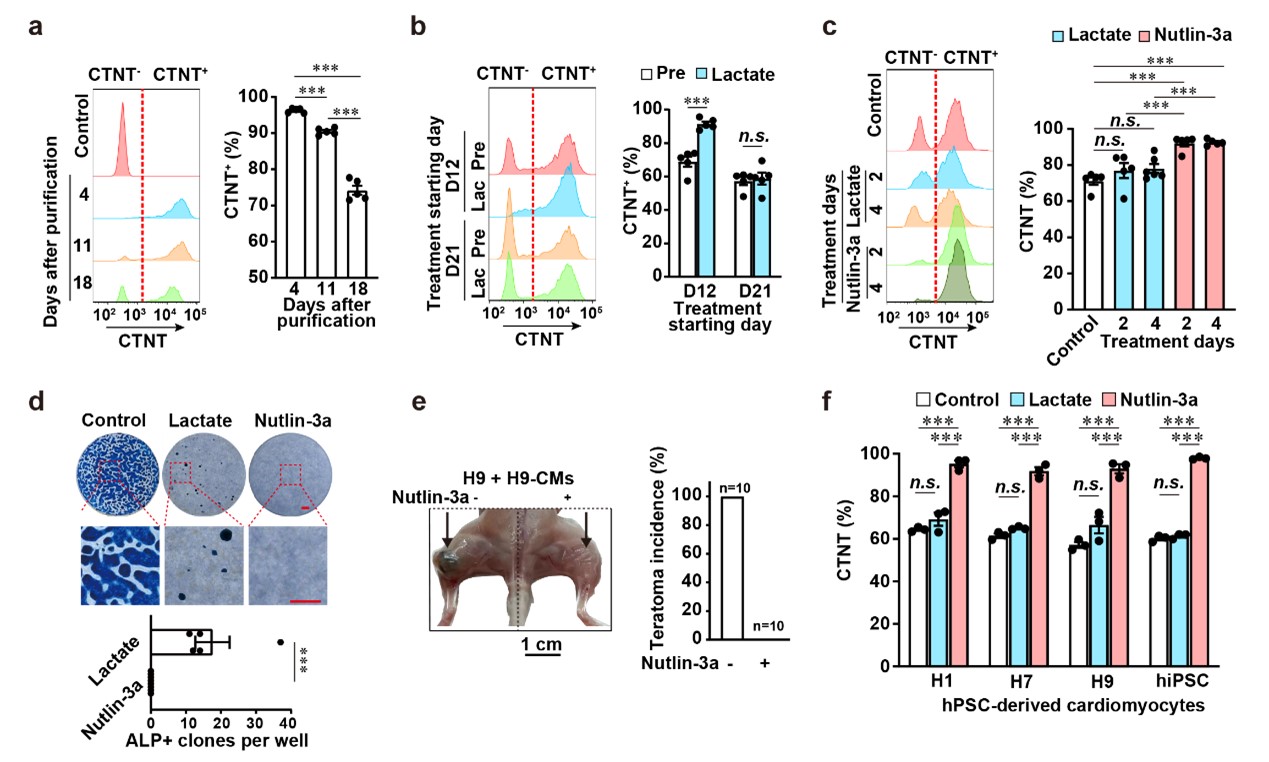Researchers Developed a Simple and Efficient Method for Purification of hPSC-CMs via Activating p53
The research team led by Prof. YANG Huangtian from the Shanghai Institute of Nutrition and Health (SINH), Chinese Academy of Sciences (CAS) reported a simple and efficient method for purification of human pluripotent stem cell-derived cardiomyocytes (hPSC-CMs) via activating p53 in Acta Pharmacologica Sinica on April 17, 2025.
hPSC-CMs hold great values for developmental studies, disease modeling, drug screening and toxicity test, cell therapy, and beyond. Achieving high-purity of hPSC-CMs is essential for their application. Purification of hPSC-CMs by switching the culture medium to lactate-rich, glucose-free, and nutrient-poor purification medium (lactate-method) has been widely-used, whereas it would induce “ischemic-like” phenotypes with spontaneous arrhythmic activity, abnormal calcium handling, and shortened sarcomere. Moreover, the majority of applications require more maturity of hPSC-CMs, which needs to extend cultivation time. However, prolonged cultivation results in the expansion of non-CMs, leading to a decreased purity of hPSC-CMs. Furthermore, purification efficiency of the lactate-method for hPSC-CMs declines beyond differentiation day 20. Therefore, an alternative purification approach with less restrictions is required.
To address the above problem, the research team led by Prof. YANG Huangtian developed a simple and efficient method for purification of hPSC-CMs, which is based on the different sensitivity of cardiomyocytes and non-cardiomyocytes to activation of the death-regulatory signaling p53. Flow cytometry analysis showed that the purification efficacy of H9 human embryonic stem cell (hESC)-derived CMs (H9-CMs) was concentration dependent upon use of nutlin-3a, a p53 activator, up to 40 μmol/L for a 2-day treatment followed by a 4-day recovery and similar purity rate of H9-CMs was observed between 20 and 40 μmol/L of nutlin-3a. The purification efficacy of the lactate-method and nutlin-3a method was comparable for hESC-CMs at differentiation day 12, whereas the nutlin-3a method but not lactate-method maintained a high purification efficacy for hESC-CMs from differentiation day 21. The high purification efficacy of nutlin-3a at 20 μmol/L was further confirmed in the CMs derived from various hPSC lines at differentiation day 21.
Moreover, the similar proportions of nodal-, atrial-, and ventricular-like CMs, and the comparable properties of action potentials of ventricular-like CMs were detected between the control and nutlin-3a-purified H9-CMs. Further, nutlin-3a at 20 μmol/L did not show cytotoxicity to H9-CMs. Flow cytometry analysis, alkaline phosphatase activity, and teratoma formation assay showed the highly efficient removement of undifferentiated hESCs, which is p53-dependent.
In summary, this study developed a novel method for purification of hPSC-CMs with several advantages. It is a simple, universal, and straightforward approach with high efficacy of purification for hPSC-CMs across early and later (over 20 days) stages. It effectively removes undifferentiated hPSCs, thereby enhancing the safety of applying hPSC-CMs in cell therapy, and the purified cells exhibit normal morphology and electrical properties. Thus, this alternative method for purifying hPSC-CMs could be employed under conditions that require extended culture times, thereby reducing assay variations in applications, such as disease modeling, toxicity test, drug screening, etc. It also provides seed cells with higher safety for cell therapy.
The research was supported by grants from National Key R&D Program of China, National Natural Science Foundation of China, Youth Innovation Promotion Association CAS, and “LingYan” Research and Development Project.

A simple and efficient method for purification of hPSC-CMs. (Image by Prof. Yang's team)
Paper Link:https://doi.org/10.1038/s41401-025-01543-5
Media Contact:
WANG Jin
Shanghai Institute of Nutrition and Health,
Chinese Academy of Sciences
Email: wangjin01@sinh.ac.cn
Web: http://english.sinh.cas.cn/


